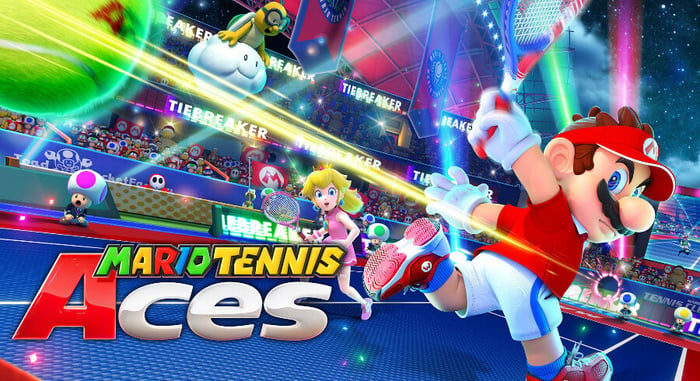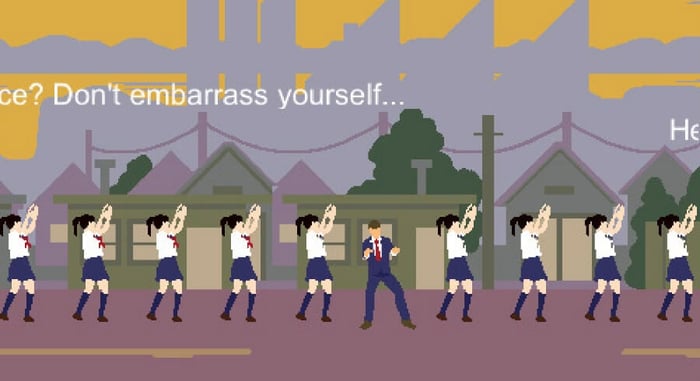
The Magical Toys R Us of Old
UPDATE: After writing this article, Toys R Us announced that they were closing all of their stores. The long-term future of the brand is still in question, but it doesn't look good.
You may have heard that Toys R Us is planning on closing up to 182 stores between February and April this year. For younger folks, this may not strike you as surprising. Between online sites like Amazon and huge toy departments in stores like Target and WalMart, a giant dedicated toy store probably sounds absurd, but back when I was a kid, a trip to Toys R Us was a special thing, especially when it came to shopping for video games.
I have a lot of fond memories of wandering around various stores looking for video games, with my parents, of course. Any time we’d go to the mall I had to drop by Kay Bee and check out their Atari and NES games. Best and Clover always had cool stuff on clearance. Sears was the first place I saw Donkey Kong Country on display. Electronics Boutique was where I got my first glimpse of Ocarina of Time in action. My sister would be looking for music in Sam Goody while I was on the other side of the store drooling over Atari games. I could go on for days about how much fun it used to be looking at the boxes lined up behind the counters of every store we walked in to because retail shopping was such a different experience in those days. Toys R Us, though, was on an whole other level. Toys R Us was pure magic.
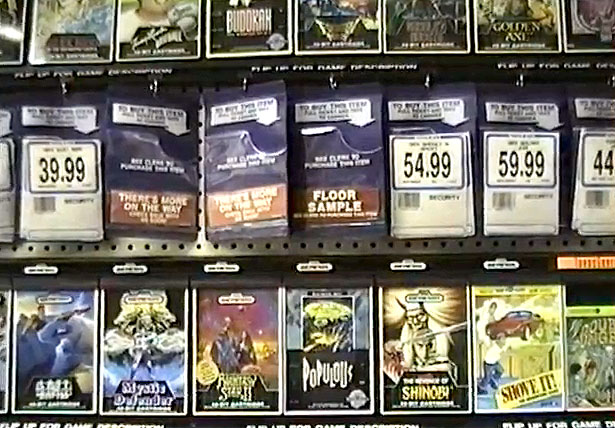
It's harder than I thought it would be to find images of this set up as I remember it.
The way it used to work, at least how I remember it, was via this completely bananas ticket system. You’d walk into the video game department, which to a small child seemed absolutely humongous, and there would be these plastic flaps lining the walls as far as the eyes could see. On the front of the flaps would be the front of the game’s box art, and the back would be, well, the back of the box. You could just walk up to whatever game you wanted and lift the flap to see what was there. This was brilliant and special because in most places the games were behind a counter of some sort. You’d have to ask for help so someone could show you the box. In the TRU of old, the power was in your hands. Underneath the flap was a pouch full of tickets. You grab a ticket, pay for it at the register, and then they’d send you to “the booth.” There, you would hand over your ticket and the person behind the counter would grab your brand new game and hand it over.
Logistically, I know how flawed this system is. I know there’s no way to be 100% sure that there aren’t too many tickets on display, leaving an opportunity for a customer to grab one and wait in line only to be told after doing so that the game was actually sold out. But from a customer interaction experience perspective, it was wonderful. Think about that. The games themselves still got to maintain that sense of wonder because they were still locked up behind a counter somewhere, but every single game the store carried was always on display within reach of the kids who were there to buy them. It was always a fun experience to get a new video game, but nothing beat the experience of doing so at a Toys R Us.
But that wasn’t all. No, not by a long shot. I don’t know if this was true everywhere, but around me Toys R Us was the only place that had what we now refer to as interactive units. I specifically remember the Super NES one, but it’s entirely possible it was used for all Nintendo products at the time. Now, I’m not talking about things like the old Game Boy interactive with the big TV displaying the Game Boy games on it (as cool as that was). I’m talking about this crazy interactive computer thing they had at TRU. There was a big monitor that ran a steady stream of game trailers, but there was also this panel covered in buttons underneath. It wasn’t quite like a keyboard with raised buttons though, it was a flat panel, sort of like the buttons on an Odyssey 2 keyboard, or the Atari 400. There was an overlay with tons of SNES games on it, and when you pressed one of the buttons, an overview video for whatever game you pressed would display on the screen. I wanted one of those in my house so badly. Of course now, YouTube exists. But back then, watching videos of upcoming video games was a rare treat, and nobody did it like Toys R Us.
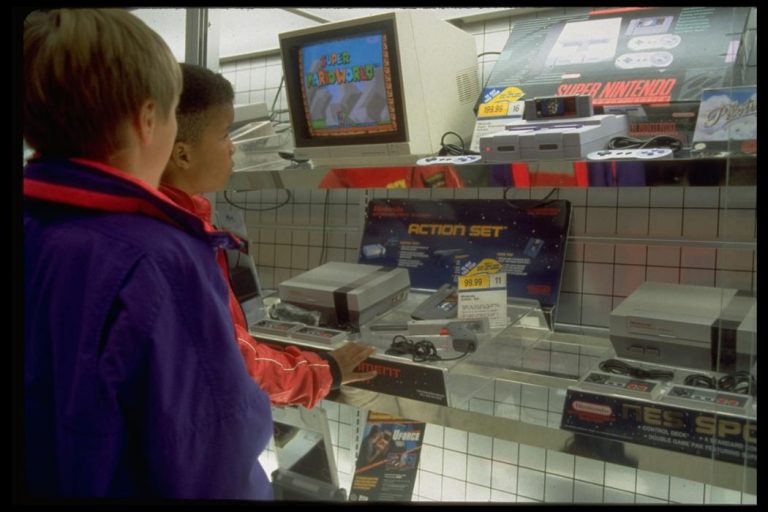
Some stores even had these awesome console displays set up. Image: Gettyimages
At a certain point, they did away with the booth/flap system and moved on to clamshell cases. I think this was during the PS2/GBA era (though it seems some stores kept up the flaps longer than others). Gone were the inefficient tickets and totally awesome flaps of old, and in their place were slotted shelves with the actual games themselves sitting on them, except they were in these thick clamshell anti-theft cases, kind of like what you still see at Best Buy. The game sections also moved to a corner of the store instead of just in the aisles. This section became known as the R-Zone. It was during this era that I started working at Toys R Us, so I’m VERY well acquainted with how difficult this was to keep up. It was a lot of work getting those games in those cases, and restocking was a pain as well. Plus, if one of the games made it out of the video game section and someone who didn’t work in R-Zone tried to open the case, things could get very frustrating. From a customer’s perspective though, this was also super cool because you could just go and pick up the game and look right at it. Yes, they could be somewhat problematic to slide back in their shelves, and since the product was live on the floor there was an endless number of customers who would never ever dream of even thinking about considering putting the game they were looking at anywhere in the vicinity of where the game actually belongs, but if the section managed to be kept up well, it looked and shopped very cool.
Fast forward to today and Toys R Us, the coolest place to shop for videogames, has become one of the most frustrating. If you haven’t been in a TRU for a while, all the video games are behind these glass doors now. You can actually see the bulk of their inventory, but only if the folks who work there take the time to actually merchandise what they have. This isn’t meant to disparage those who work at TRU for not taking the time to do so because there are almost no TRU employees in the video game department at any given time. That means that shopping for video games at TRU has become something like trying to find help at a Home Depot. You can wait in line at the one open register and hope that the person there has access to the keys to get a game for you, but that only works if you in fact know what you want to buy. There’s no looking at the back of the box for more details. There’s no kid holding the box in their hands excitedly waiting to tear it open in the car on the way home. It’s just glass doors and waiting for someone to help you.
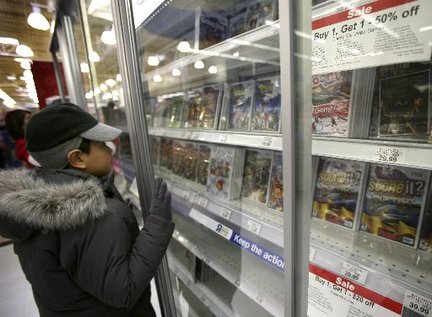
This kind of says it all. Image: NJ.com
Warning: Over-detailed, long-winded merchandising rant incoming.
This is also problematic from a merchandising perspective because many games in these cases are “bookshelved,” meaning you can only see the spine of the box. Sure, if you know exactly what you’re looking for this isn’t a problem. But for the uninformed parent or child looking to get a new game, whatever titles are bookshelved have a very small chance of being seen. For example, I was in my local TRU the other day to buy a new set of Joy Cons for my Switch. In their Switch games case, they had a total of 6 shelves dedicated to holding games. The bottom 2 shelves were dedicated to Wii U games, with the remaining 4 holding the Switch games. As you probably have heard, the Switch is the hottest selling thing in gaming right now, and following this holiday season, stores are finally all stocked up on Switch retail games, which is great. Except this section had Switch games bookshelved, which was problematic for a couple of reasons. First, there’s no situation where it’s okay to dedicate 2 of your Switch shelves to Wii U games that aren’t going anywhere. If they had some tremendous Wii U stock, sure. I get that. But they didn’t. Rodea: The Sky Soldier had 2 full facings, and the bottom shelf was half empty. If you’re going to use Switch space to display Wii U games, the wii U stuff needs to be as minimized as possible. I would rather give Farming Simulator on Switch a facing than give spaces to Rodea, no matter how cool Rodea is. And you know what else? There’s an entire case dedicated to 3DS a few feet away that has tons of empty space in it. That’s where your Wii U games go. Not taking usable space away from Switch games.
But even if that weren’t possible, and you absolutely HAVE to bookshelf some games, you need to be smart about which games you do that to. (This isn’t just for Switch, mind you, it’s just the example I’m using now.) The top row of Switch games had every 3rd or 4th game bookshelved. It’s not a great look, but it’s efficient when it needs to be. The issue I had was that Axiom Verge had a full facing and Batman: The Telltale Series was bookshelved. Now, Axiom Verge is a masterpiece, and it deserves all the attention in the world, but Batman is Batman. That game isn’t for everyone, but the box art is the Batman logo, and that draws attention. The box art to Axiom Verge has a weird digitized head on it. It’s neat if you’ve played the game and you’re a fan, but it’s not drawing anyone’s attention. In every scenario, that Batman game should have had the full facing with Axiom Verge bookshelved, but if you’re someone who doesn’t know much about games and you’re the one stuck in the game section filling the cases, why would you think about what games deserve visibility. You’re probably on night crew and you’re just making things look as pretty as you can so you can move on to the next section that needs stocking. This problem is much, much worse for PS4 and Xbox One because there are so many more titles available on those platforms, and the space dedicated to displaying the games is woefully inadequate, resulting in the bulk of the available games being bookshelved, which is about as far from an optimal or fun shopping experience as you can get.


But I digress. I can talk about merchandising all day, but in the end, this is what’s become of TRU, and in my unsolicited opinion, a large part of why they can’t seem to rediscover their place in the modern retail market. Their video game section needs to be re-evaluated around the concept of shopping being fun, because that’s what TRU should be all about. Fun. I’m not saying they should bring back the flaps, but they have to do something.
The good news is, they aren’t closing all their stores, and the ones that remain have the chance to recapture that magic. I hope they can pull it off because I was a Toys R Us kid, and I want my kids to be too.



